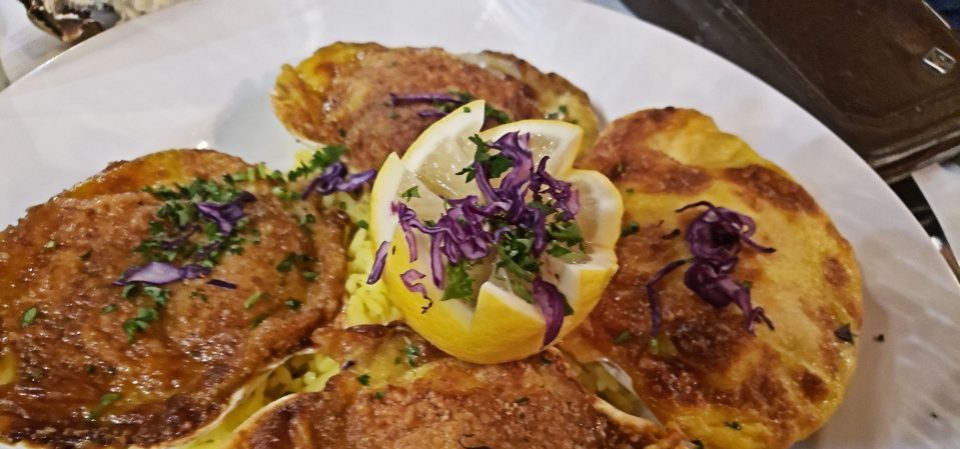 Basically it is Tellicherry (origin: India) Tellicherry peppercorns are like San Marzano tomatoes: they need to come from Tellicherry, a city on the Malabar coast of Kerala in India. They’re considered some of the finest peppercorns in the world, and one of the few “names” in pepper that people are familiar with.
Basically it is Tellicherry (origin: India) Tellicherry peppercorns are like San Marzano tomatoes: they need to come from Tellicherry, a city on the Malabar coast of Kerala in India. They’re considered some of the finest peppercorns in the world, and one of the few “names” in pepper that people are familiar with.
Tellicherry Peppercorns and “regular black pepper” both come from the exact same vine. (And for that matter, so do green and white peppercorns, but that’s another subject for another blog post.) All are the species called Piper Nigrum.
At the end of the growing season, in February and March, the pepper fruit is picked from the vine. The pepper is dried over a series of days and eventually shrivels and turns into what we know as black peppercorns. All of the peppercorns are then shipped to “garbling” facilities. These are places that sort the peppercorns by size and then bag them. The sortation machines have several different large flat metal screens with thousands of identical holes in them. The machines shake the peppercorns so that the smaller peppercorns begin falling through the screens. The smallest peppercorns fall to the very bottom screen. Once sorted, the various peppercorn sizes are called different things and sold for different prices.
So a Tellicherry peppercorn is actually determined by size. When a black peppercorn is 4.25 mm pinhead or larger, it’s “Tellicherry.” That’s all there is to it. Because Tellicherry are so much bigger than the other peppercorns, they make up a much smaller percentage of the crop. Oftentimes they represent 10% or less of any given harvest. There’s less of them, so command a higher price at market … Our Tellicherry has strong lime, lemon and orange notes. When you grind our Tellicherry, the citrus aroma is immediate and beautiful [ Tellicherry Pepper]
To Robin and I, it is some of the best black pepper available, especially if you grind it as you need it.
The other pepper I use is Aleppo Pepper, which comes from The Aleppo pepper (Arabic: فلفل حلبي / ALA-LC: fulful Ḥalabī) is a variety of Capsicum annuum used as a spice, particularly in Middle Eastern and Mediterranean cuisine. Also known as the Halaby pepper, it starts as pods, which ripen to a burgundy color, and then are semi-dried, de-seeded, then crushed or coarsely ground. The pepper flakes are known in Turkey as pul biber, and in Armenia as Haleb biber. The pepper is named after Aleppo, a long-inhabited city along the Silk Road in northern Syria, and is grown in Syria and Turkey. It is fairly mild, with its heat building slowly, with a fruity raisin-like flavor. It has also been described as having the flavor of “sweetness, roundness and perfume of the best kind of sundried tomatoes, but with a substantial kick behind it.” The most common use is in the form of crushed flakes, which are typically slightly milder and more oily than conventional crushed red pepper, with a hint of saltiness and a slightly raisin-like flavor. Unlike crushed red pepper, the flakes contain no inner flesh and seeds, contributing to the mildness. Crushed Aleppo pepper can be used as a substitute for crushed red pepper or paprika. The spice is a common ingredient in some of the dishes that comprise a meze. [Meze is a collection of finger foods. A meze is a big part of the dining experience in Eastern Mediterranean, Middle Eastern, and Arab countries. The word “meze” means “taste” and/or “snack.” The concept is very similar to the tapas of Spain, but with different ingredients.] Aleppo pepper has a moderate heat level with a mild, cumin-like undertone, a bit of fruitiness, and a hint of a salt and vinegar. [Wikipedia]
Try these two types of pepper. Hopefully, you will be pleasantly surprised. Cheers!



Reblogged this on Treasure Valley Food and Wine Blog and commented:
Interesting pepper article.
LikeLike